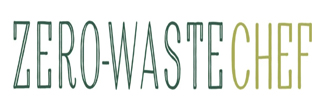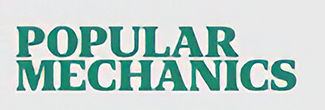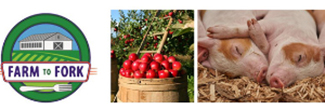Eat or Toss Interview
by R. Jackson
EatOrToss.com/pumpkins-for-pigs 09-16-2024
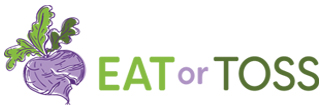
Farms and animal sanctuaries want your seasonal cast-offs! Nonprofit Pumpkins For Pigs connects would-be waste to eager animals.
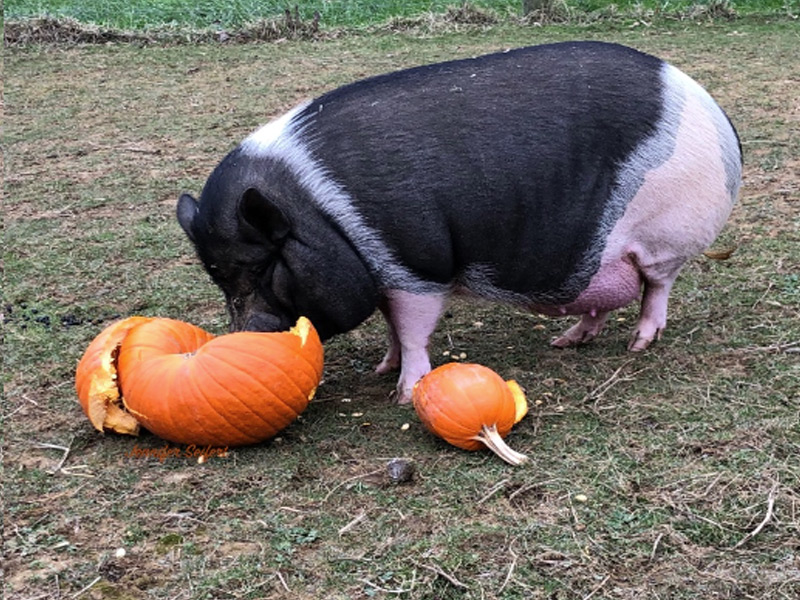
Today, we’re excited to share a profile of Pumpkins for Pigs, an organization that began with a goal of directing discarded pumpkins to pig farmers eager to give their animals a healthy treat. Today, the group’s mission has expanded; they now work with farms, animal sanctuaries, vineyards and other organizations to find uses for foods and items, especially seasonal goods, that consumers might otherwise trash. Think Christmas trees and wreaths, discarded kiddie pools and plastic playhouses (goats love climbing on them!), backyard vegetable garden surpluses and more. While Pumpkins for Pigs is based in Leesburg, Va. and sometimes helps with pickup, the core of the organization’s work is in creating a database where people can divert potential waste by finding donation-eager farms and other entities in their communities. Look up donation sites in your state here. And if your organization would like to receive donations, sign up here.
Now over to Pumpkins for Pigs founder Jennifer Seifert for some Q&A with EatOrToss editor Rachael Jackson.
Tell me about Pumpkins for Pigs.
Our mission is to reduce food waste one pumpkin at a time. On Pumpkins for Pigs’ website, you’ll find listings of donation sites, by state, as well as guidelines for donating. By inviting neighbors to visit their local farms and animal sanctuaries, we are reducing food waste, making animals happy through nutritious feed, highlighting local businesses, and building community. We call it a quadruple win. Now, more than ever, we also hope to reduce feed and enrichment costs for our donation sites.
What inspired you to start this organization?
Each year, I would buy pumpkins and they would still be in great shape when it came time to put a wreath on the door. I kept thinking there had to be a better way. One evening while picking up eggs from our local farmer in the fall of 2017, I mentioned my growing internal struggle. He invited me to drop off the pumpkins: it would be a nutritious treat for his livestock (pigs, chicken, etc.) and had natural deworming properties which are important that time of year. An idea was born. I reached out to everyone on the local farmers’ market flier and found farms and an animal sanctuary that were willing to try this idea: invite the public to drop off their pumpkins, gourds, and hay bales to farms when they went out to pick out their Christmas tree. It worked! Neighbors were willing to add to their already busy schedules to prevent food from going to the landfill. We would not exist if it were not for the donation sites taking a chance on this idea or the community making the extra effort: we are so grateful for the ongoing support and action.
What types of places accept pumpkins and other items that might otherwise go to waste? What do they do with them?
Our donation sites are farms, homesteads, farmettes, ranches, animal sanctuaries, animal rescues, or similar organizations with animals that eat produce, evergreens, and other donated items. Animals typically include pigs, goats, sheep, bovines, horses, donkeys, chickens, geese, and other fowl.
Do the drop-off locations accept other types of organic waste?
Our accepted items have grown beyond food, based on the requests and needs of donation sites. We added evergreen trees when we realized not all communities have curbside pick up of trees; goats love them and some locations submerge them in ponds to create aquatic environments for fish. Initially, we did not accept carved pumpkins for feed due to their rapid decay, making them presumably unviable except for compost. Donation sites asked for them. And I visited a local farm that had a large flock of fowl and learned their need for the throwaway kiddie pools that are so often left by trash cans come Labor Day weekend when kids go back to school. We added them to our list. We learned some donation sites would benefit from the used outdoor plastic playhouses that kids grow out of; it provides more places to climb for goats. We continue to evolve as we find more and more ways to serve our communities.
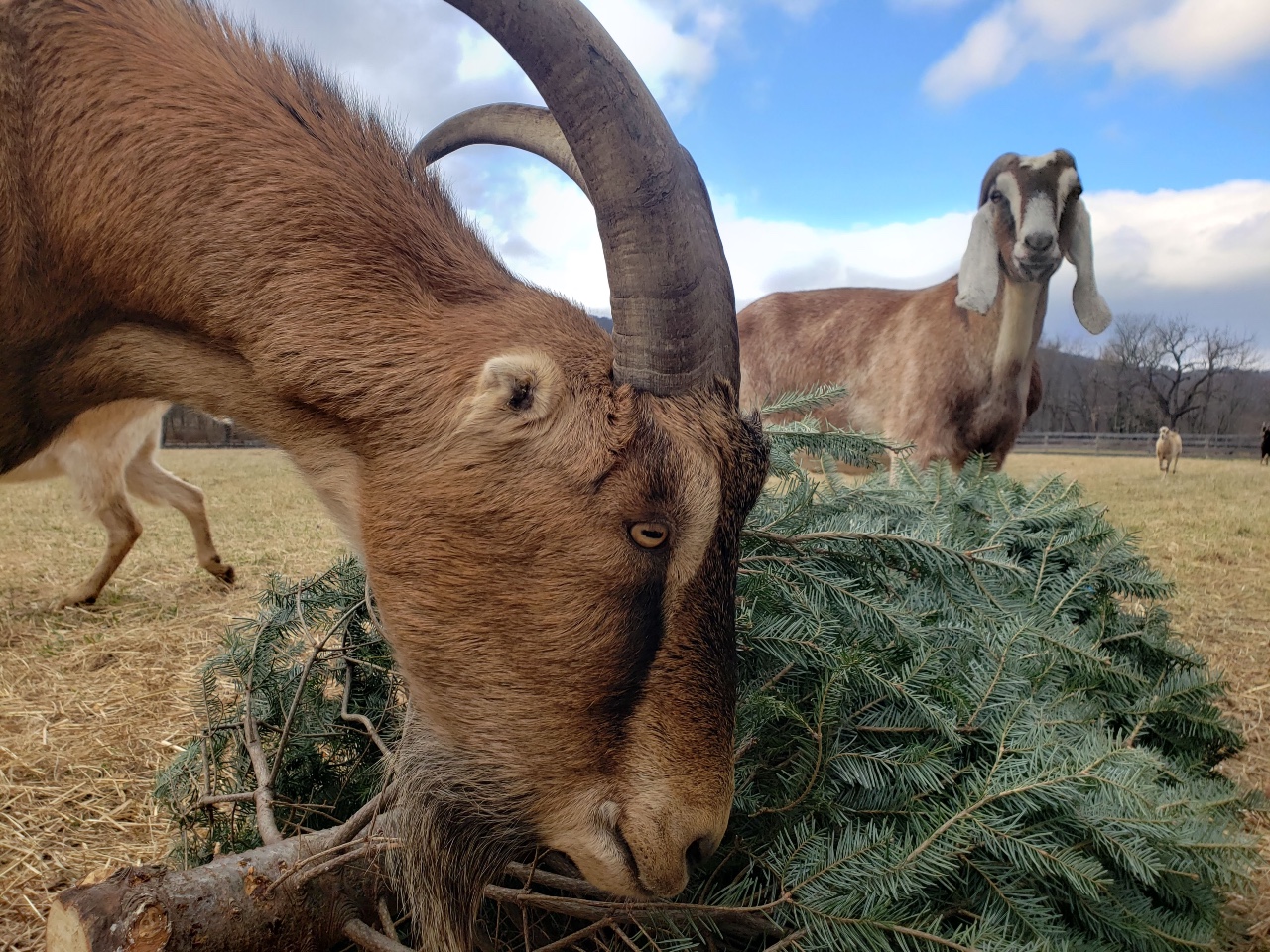
Goats chow down on a Christmas tree treat. (Image courtesy of Pumpkins for Pigs, originally from 56 Hooves in Loudoun County, VA.)
Are there any drop-off locations that surprised you when they signed up?
In 2021, a homesteader found us on social media and shared what we were doing in a couple homesteader groups, unbeknown to us. Within 24 hours we had 70 new donation sites registered across the country. At that moment, I realized there was a place for us in the food-waste-reduction landscape, filling an overlooked niche by using viable foodstuffs for feed ahead of the better known compost solutions.
We also had an animal sanctuary ask us for baked goods to help several severely malnourished horses add calories and weight. Donation sites can now list baked goods as an item they’d like to receive. As heartbreaking as it was to hear about the horses, it also gives me hope, not just on food waste reduction, but on the incredibly important work our partners are doing every single day.
When you approach potential donation locations are they usually all in right away?
It depends on their business model and whether we are additive to that model. Typically, our best matches range from hobby farms to mid-sized organizations. Donation volume must meet the needs of the sanctuary or farm. A commercial hog producer or an certified organic livestock farm is unlikely to participate because they must ensure all feed aligns to specific standards that enable them to meet their obligations. However, as always, we are open to learning how we might support more organizations in reducing food waste holistically.
What standards do people need to follow when donating pumpkins? What if they’re painted or moldy, for example?
All donations must be free of mold and toxic properties, including non-water-based inks and paints, glitter, gemstones, clorox baths (a preservation technique), and similar decorations which are not consumable items by anyone and can make an animal very sick. We want to be additive to our donation sites’ existing processes, not add more work for them, and we rely on our neighbors’ vigilance in checking and preparing donations. We are looking to partner with composting organizations to give communities other choices for non-viable items. We also welcome creative pumpkin decorating tips that we can share in the resources section of our website.
Tell me about the journey of starting Pumpkins for Pigs. What’s been easy, what’s been hard and how can the community support your efforts?
Our biggest challenges continue to be fundraising, volunteers, and transportation. Our services are free of charge to donation sites. Financial donations are critical to maintaining our operations (the behind-the-scenes and not-so-sexy part of any organization) that enable us to continue to exist, to scale, and offer more and better programs to our communities. We accept donations of all dollar amounts via PayPal, Venmo, and old-fashioned checks. Grant writers and corporate sponsorships would also be amazing support in this area. We also need volunteers to help promote our work in communities across North America (think tables at farmers or other markets, social media posts, fliers), facilitate collections in their communities and publish that work on social media, and be a part of our working Board of Directors (1 year increments). Finally, we are always in need of trucking and other transportation organizations for in-kind donation of transporting collecting donations to donation sites, particularly in November when collection efforts are at their peak. (Who knew collection was the easy part?!)
What’s next for Pumpkins for Pigs?
Today, we offer three programs. Our original program – Pumpkins For Pigs aka Fall and Winter Donations program – is what most know us for: redirecting viable Fall and Winter decorations back to farms and animal sanctuaries for feed. During the pandemic, we added a Backyard Excess program to redirect all the amazing produce from backyard gardens to farms and animal sanctuaries for nutritious feed. Recently, we added a Pantry Extras program where we partner with food banks, pantries and related organizations to redirect excess but viable food items to donation sites. We have other programs we would like to launch that require more funding and more volunteers to bring them to fruition. We want to deepen our relationships in the communities we serve and expand to offer those services in more communities
What other tips do you have for people looking to keep their pumpkins and other items out of landfills?
If you don’t see a donation site near you, try
- New Recipes. Look for soup and other recipes that use pumpkins and gourds. Roasted pumpkin seeds are a great afternoon treat and super easy to make. Many recipes have freezing instructions so you can enjoy it throughout winter. Make extra pumpkin pies and freeze them for later.
- Ask producers at your local farmers’ market if they would accept them (and then invite them to register as a Pumpkins for Pigs Donation Site!)
- Contact your local food banks to donate your pumpkins and time to make prepared foods for their partners.
- Find a composting program or organization near you. Check local municipalities and landfills for pilot programs too.
- Create a compost pile in your backyard or for your neighborhood.
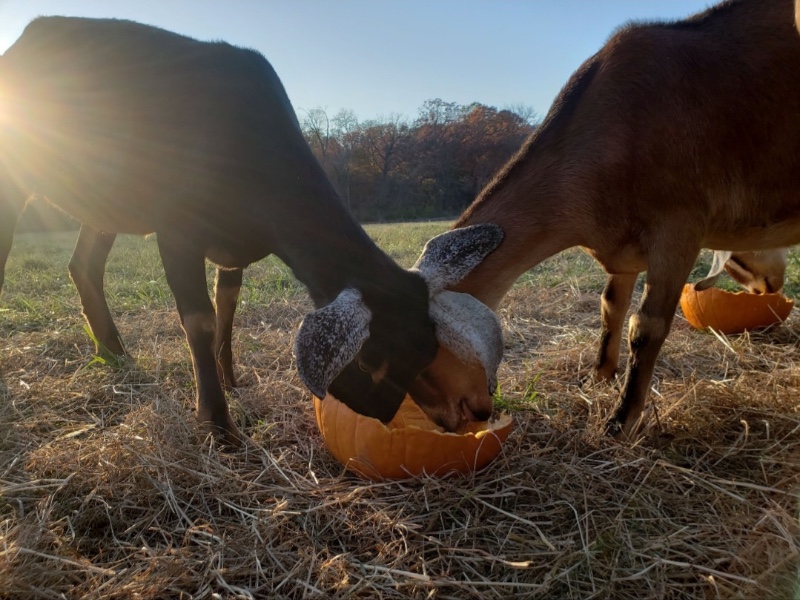
Two goats share a donated pumpkin. (Image courtesy of Pumpkins for Pigs, originally from 56 Hooves of Loudoun County, VA. )
Note: This conversation was conducted over email and has been lightly edited. All images in this post are 1) adorable and 2) courtesy of Pumpkins for Pigs, some originally from 56 Hooves in Loudoun County, Va.
Categories: Food Waste Warriors, Happenings
© 2024 EatOrToss LLC. Content may not be duplicated without express written permission from EatOrToss LLC. All information posted on this blog is thoroughly researched, but is provided for reference and entertainment purposes only. For medical advice, please consult a doctor. Please see our terms.
© EatOrToss LLC. EatOrToss’s text and images cannot be re-published or pasted in forums or on social media websites without written consent. That said, we hope you share links to our content widely—that support our operations so we can continue to provide you with more great information about your food! Read more at: https://www.eatortoss.com/pumpkins-for-pigs/

Mailing Address
P. O. Box 1096
Leesburg, VA 20177-1096











